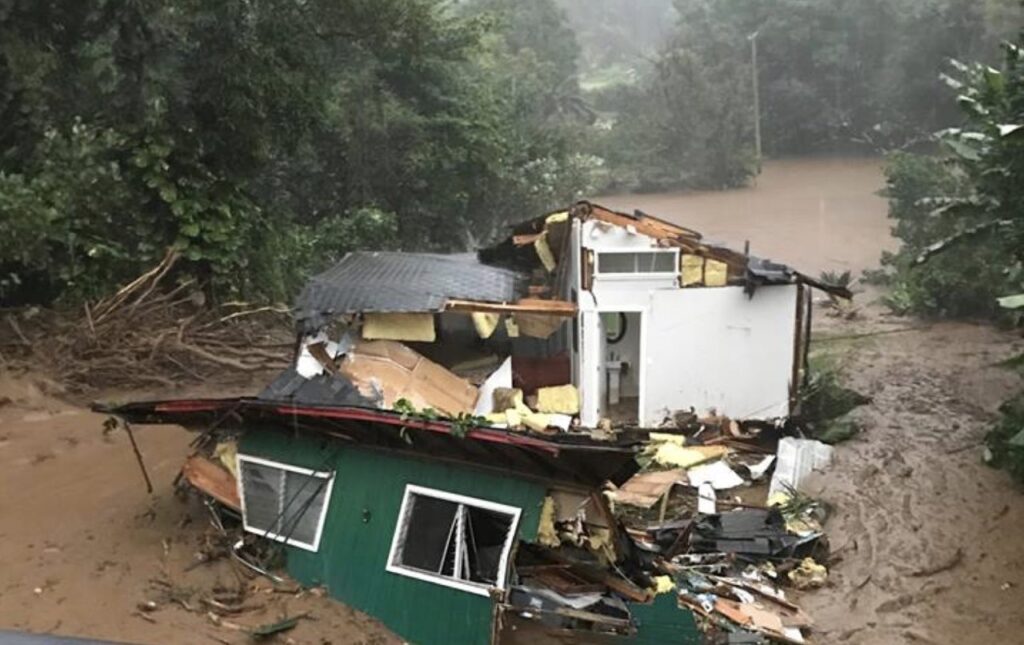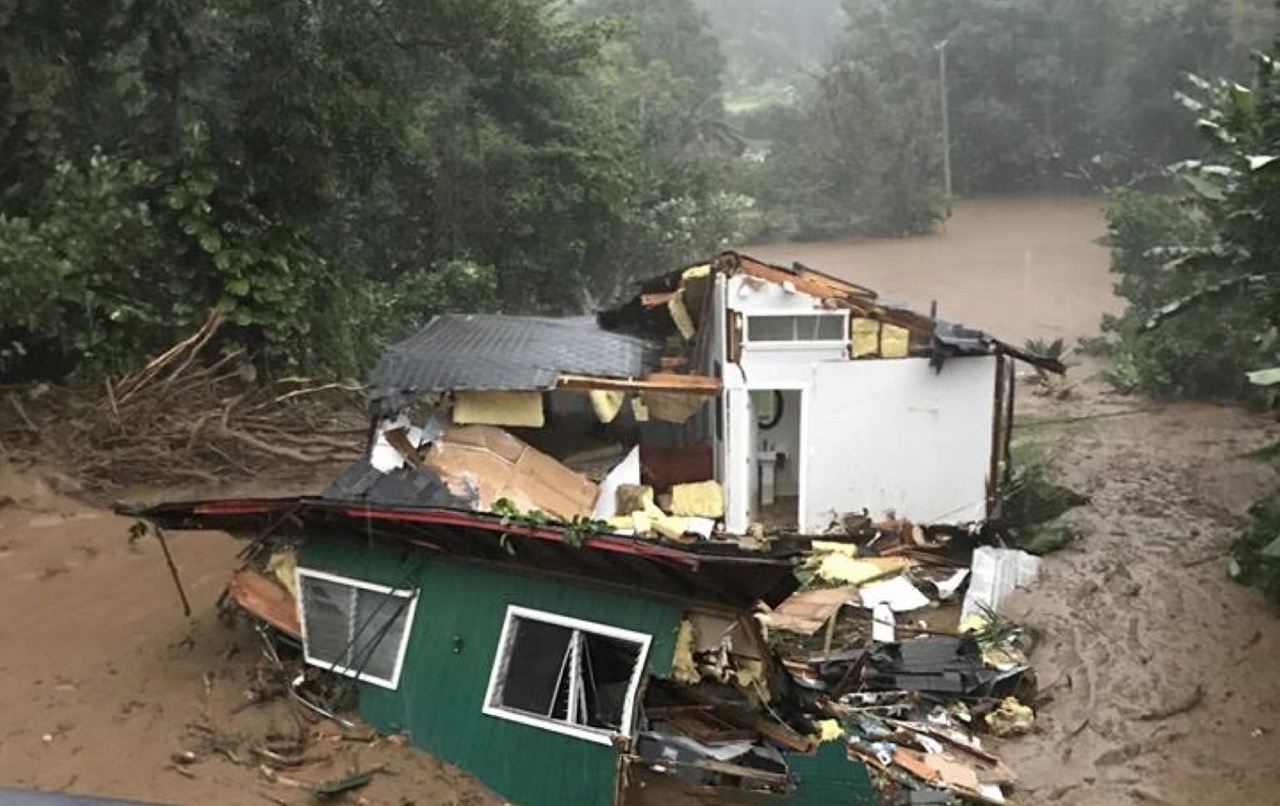
For 15-year-old Navahine Fukumitsu, climate change has made it harder for her family to farm kalo on its kuleana lands in Hakipuʻu, O’ahu, which it has done for more than ten generations.
“[C]limate change is altering the growing season, decreasing crop yields, and threatening Navahine’s ability to continue this cultural practice. Among other threats, heavy rains, which are becoming more common, flood the ancient ‘auwai, destroying crops, and forcing Navahine’s ‘ohana to spend days of hard labor rebuilding the ditch system. On the other extreme, extended drought periods dry out and damage the ‘auwai and contribute to decreasing stream flows, which can harm wetland kalo that is dependent on cool, flowing water. The extreme weather fluctuations also degrade habitat for native stream life and waterbirds that are dependent on this ecosystem for their survival and are part of the landscape of resources that Navahine’s ‘ohana both relies upon and cares for in perpetuating traditional farming practices. Additionally, rising seas are infiltrating the groundwater table and raising the pH of the soil, which also reduces crop yields; some of the ‘ohana’s lo‘i are located only six inches above sea level, and if urgent reductions in greenhouse gas emissions are not made, these lands will be underwater within Navahine’s lifetime.”
That’s according to a complaint Fukumitsu and 13 other Hawaiʻi youths filed last June against the state and its Department of Transportation (DOT) for failing to follow through on direction from the Legislature and other agencies and even its own plans on how to meet greenhouse gas (GHG) emission reduction targets.
The complaint, filed by attorneys with Earthjustice and Our Children’s Trust, alleges that the DOT’s practices and policies have led to increased emissions from the transportation sector that have, in turn, contributed to harmful climate change impacts the 14 young plaintiffs have experienced and expect to endure for years to come.
The complaint describes how sea level rise, changing weather patterns, and increasing ocean temperatures and acidification are harming their ability to live in a clean, safe, healthful environment, and in the case of Nawahine and others, to continue traditional Hawaiian practices.

Despite Hawaiʻi being a leader in adopting climate change legislation and setting ambitious greenhouse gas emission reduction targets, its 2045 emissions are projected to be just 30 percent lower than they were in 2016, the complaint states. (The 2008 Hawaiʻi Clean Energy Initiative, or HCEI, set a goal of reducing greenhouse gas emissions 70 percent by 2030.)
The transportation sector shoulders a lot of the blame for the state falling short of its goals, the plaintiffs argue.
“Transportation is increasing as the dominant source of carbon dioxide emissions in Hawai’i, from approximately 49 percent of total carbon dioxide emissions in 2008 to approximately 59 percent in 2018,” it states. And according to a 2017 Department of Health report, transportation emissions are projected to increase 41 percent between 2020 and 2030, while emissions from other sectors are projected to drop.
This, despite a 2011 HCEI roadmap that described how to meet its emission goals: 1) reduce vehicle miles traveled to four percent below 2011 levels by 2020, 2) put 40,000 electric vehicles on the road by 2020, and 3) reduce ground transportation petroleum consumption 70 percent by 2030.
That same year, the DOT published its Hawai‘i State Transportation Plan, which aimed to support the HCEI goal by creating a transportation system that included bicycle and walking options, as well as more use of alternative fuels and electric vehicles.
Still, a 2015 analysis of the HCEI commissioned by the state Department of Business, Economic Development and Tourism found that the transportation sector was falling short.
In their complaint, the plaintiffs noted that the DOT has been adding 31 new miles of vehicle lanes each year since 2000, which “does not alleviate traffic or reduce greenhouse gas emissions from transportation. Rather, it proportionally increases vehicle miles traveled, increasing vehicle emissions and exacerbating climate change. If this trend continues, an additional 20.25 [million metric tons of carbon dioxide equivalent emissions] will be added to the atmosphere between 2021 and 2050, moving Hawai‘i even further away from achieving the Zero Emissions Target.” (In 2018, the Legislature passed a bill that became Act 15, which established a state “zero emissions” target to sequester more atmospheric carbon and greenhouse gases than were emitted by no later than 2045. After January 1, 2020, agency plans, decisions, and strategies were required to consider their impact on the state’s ability to “achieve the goals in this section, weighed appropriately against their primary purpose.”)
The department has not reduced barriers to electric vehicle adoption, electrification of transportation, public transit, walking, and cycling, the plaintiffs argue.
The complaint also notes that Hawai’i currently has the second lowest number of charging ports per EV in the country, the DOT has still not funded or implemented its decade-old Statewide Pedestrian Master Plan, it’s made limited progress towards implementing a 2003 Statewide Bike Plan Hawai’i, and it has not convened the Sustainable Transportation Forum for the past five years.
“In response to a public records request, HDOT identified only five ‘highway plans and actions’ it has taken since 2011 to address greenhouse gas emissions: (1) implementing an internet broadband pilot program to increase opportunities for rural commuters to work from home; (2) administering the federally funded Transportation Alternatives Program which to date has awarded $5 million (approximately 0.0036% of HDOT’s total 2021 operating budget) for third-party, multimodal projects; (3) securing a vendor to assist state and county agencies with procuring and ordering EVs; (4) adopting SmartTRAC, a program that assesses how well transportation projects address state priorities relative to the requested funding; and (5) conducting a 2019 test of a sustainable concrete mix designed to reduce the carbon footprint of road construction,” the complaint states, adding that these actions are “wholly inadequate.”
Given the DOT’s track record, the plaintiffs asked the court to declare that the state and DOT have a public trust obligation under Article XI, Section 1 of the Hawai‘i Constitution “to protect and conserve the climate system and atmosphere, and all natural resources affected by climate change, for the benefit of present and future generations,” and that they have violated that section “by establishing, maintaining, and operating a state transportation system that fails to preserve, protect, and maintain Hawai‘i’s public trust resources.”
The plaintiffs also asked the court to declare that their right to a clean and healthful environment under Article XI, Section 9 “encompasses the right to a life-sustaining climate system” and that the defendants have violated that right.
The plaintiffs also asked the court for appropriate and necessary injunctive relief, including but not limited to:
1) Ordering the defendants to stop perpetuating a transportation system that breaches their public trust duty, is incongruous with climate mitigation mandates, and infringes upon the plaintiffs’ constitutional rights;
2) Compelling the defendants to take concrete steps under prescribed deadlines to bring its transportation system in line with their constitutional duties and the plaintiffs’ rights; and
3) Exercising jurisdiction and oversight as necessary, including the appointment of a special master.
The complaint argues that a declaration that DOT is violating its constitutional obligations and the plaintiffs’ rights is timely because the department is in the midst of updating its transportation plan, which will govern projects for the next decade
Furthermore, the Infrastructure Investment and Jobs Act recently signed by President Joe Biden, “channels over 1.746 billion dollars in federal funds to HDOT for transportation related projects,” the complaint states, adding that without a court order, the department will continue its long-running patterns and practices that violate its constitutional duties and the young plaintiffs’ rights.
State Response
On August 22, state attorney general Holly Shikada, one of her deputy attorneys, and a handful of lawyers from California and Washington, D.C., filed a motion to dismiss.
They argued that the relief the plaintiffs sought, such as an injunction ordering the DOT to create new regulatory programs, can’t come from the courts; that direction must come from the Legislature.
“The court cannot appoint its own super-director of the agency, particularly one that would be responsible not only for ensuring that HDOT implements a regulatory program according to judicially established deadlines but also evaluating those regulations to ensure their ‘compliance’ with the court’s directives. What’s more, the oversight plaintiffs seek could last for decades,” they wrote.
They added that the plaintiffs’ beef isn’t really with the DOT, but with the countless people who choose to use gas-powered vehicles.
“Imagine if, overnight, everyone in Hawai‘i abandoned fossil-fuel-running vehicles and switched to electric vehicles. The GHG emissions that plaintiffs complain about would drop dramatically, yet the physical facilities that HDOT maintains would exist and operate exactly the same. Thus, it is clear that HDOT is not causing plaintiffs’ injuries,” they wrote. Even if the court ordered the DOT to expand bike lanes, “private individuals would retain the freedom to choose whether to use bike lanes or to continue driving cars,” they added.
Despite the plaintiffs’ recounting of the emission reduction goals, recommendations, and plans that the DOT has failed to meet, implement, or create, the department was not required by any specific law to do so, the state attorneys argue.
“Plaintiffs cite no law requiring such plans. And where plaintiffs describe a plan or action by HDOT, they do not allege any facts that could demonstrate a violation of law—for example, they assert that HDOT has failed to timely reconvene its Sustainable Transportation Forum to work on a plan for achieving emissions reductions, but they identify no legal obligation to do so,” they stated in their motion to dismiss.
They argued that even if the youths alleged that the DOT violated its constitutional duties under an environmental law, that claim should have been addressed via a contested case hearing.
And they pointed out that youth plaintiffs in mainland cases similar to Hawaiʻi’s have lost.
“Because Hawai‘i agencies are only able to control a small portion of the globe’s greenhouse gas emissions, they cannot realistically control climate change’s local impacts, like sea level rise and shoreline erosion. The Washington Supreme Court recently rejected such an approach …, finding the plaintiffs’ concerns about emissions that a state agency had ‘allowed into the atmosphere’ could not be ‘recharacterized’ as an obligation to protect local lands and waters. This court should also reject an overbroad reading of the public trust doctrine for the same reasons,” they wrote.
They continued, “Tellingly, three other courts—one Federal Court of Appeals and two state appellate courts—have each dismissed similar cases on political question grounds. While there are some differences in the underlying state laws in those other cases, the considerations that led those courts to decline to decide a political question are equally present here. For example, …the Washington Court of Appeals held that resolving the case would ‘inevitably involve resolution of questions reserved for the legislative and executive branches.’”
With regard to an Alaska case, the state’s attorneys stated that the plaintiffs there also “sought a declaration that the state had violated their constitutional rights, that it had a public trust duty to protect the state’s natural resources, and that it had violated its public trust and other obligations by failing to sufficiently reduce greenhouse gas emissions. The court found that resolving those claims would not ‘settle’ any legal issues between the parties for a number of reasons, including that the court lacked the ability and expertise ‘to provide the plaintiffs any certain basis on which to determine in the future whether the State has breached its duties.’”
Rebuttal
In filings opposed to the state’s motion to dismiss, the plaintiffs’ attorneys clarified that they are not asking the court to take control of the DOT. They just want the court to declare that the state and DOT have violated “established legislative and constitutional mandates to mitigate climate change, in a case where HDOT itself demonstrates a need for clarity, focus, and attention.”
“Far from a ‘political question,’ interpreting and defending the Constitution is the courts’ appointed role in our democratic system,” they wrote.
Regarding the defendants’ argument that injunctive relief requires the court to make policy judgments about steps and timing necessary to achieve GHG reduction objectives, the plaintiffs pointed out, “the Legislature has already set these objectives and mandated that defendants ‘decarboniz[e] the transportation sector,’ and ‘utilize the best available science, technologies, and policies to reduce greenhouse gas emissions, with the overarching goal of achieving the statewide Zero Emissions Target ‘as quickly as practicable, but no later than 2045.’
“The Legislature has also dictated that after January 1, 2020, ‘agency plans, decisions, and strategies shall give consideration to the impact of those plans, decisions, and strategies on the state’s ability to achieve’ Zero Emissions.”
Whether or not people still chose to continue to drive gas-powered vehicles if there were more EV charging stations, electrified transportation options, etc., “specific emissions–reducing projects (such as bikeways and pathways) will never be funded or constructed if they are not included in defendants’ plans now,” given the agency’s past disregard for environmental mandates approved by the Legislature, the plaintiffs’ attorneys argued.
With regard to the state’s claim that the plaintiffs failed to identify a violation of any statute governing how the DOT functions, their attorneys countered, “[I]n attempting to relegate the constitutional public trust to some secondary, subordinate duty in relation to HDOT’s ‘statutory function,’ HDOT contradicts established law. As the Hawai‘i Supreme Court has made clear, ‘[t]he State’s constitutional public trust obligations exist independent of any statutory mandate and must be fulfilled regardless of whether they coincide with any other legal duty.’”
“Defendants, moreover, disregard the numerous statutes enacted by the Legislature to address the escalating ‘climate emergency. … Defendants seek to dismiss them as mere ‘aspirational’ goals that cannot be ‘violated’—at least not yet, until it is too late to do anything about it,” they added.
They pointed out that the Legislature recently mandated a reduction of statewide greenhouse gas emissions so that by 2030, emissions would be half of what they were in 2005, “confirming the need for near-term action in pursuing a trajectory of emissions reductions to achieve the end goal.”
The attorneys disputed the state’s argument that the youths’ claims should have been addressed in a contested case hearing first. They also explained how the decisions in the Washington and Alaska cases do not apply here.
They pointed out that unlike in Washington, the Hawai‘i Supreme Court has made it clear that the public trust relates to “protection of air and other trust resources affected by climate change,” and recognized the associated constitutional “right to a life–sustaining climate system.”
While both the Alaska and Washington cases were wrongly decided, “neither state’s constitution enshrines a judicially enforceable constitutional right to a clean and healthful environment that expressly provides that ‘any person may enforce this right,’ or includes a public trust mandate directing the state to ‘conserve and protect … all natural resources,’” they wrote.
A declaration from the court would terminate any controversy as to the existence, scope, and violation of the plaintiffs’ rights and the defendants’ duties, they argued. “Injunctive relief would similarly terminate the controversy as it would ensure that defendants fulfill their statutory and constitutional responsibilities. In sum, Youth Plaintiffs readily satisfy the standing test for declaratory relief,” they wrote.
Environmental Court Judge Jeffrey Crabtree heard arguments on the state’s motion to dismiss on January 26.
— Teresa Dawson



Leave a Reply